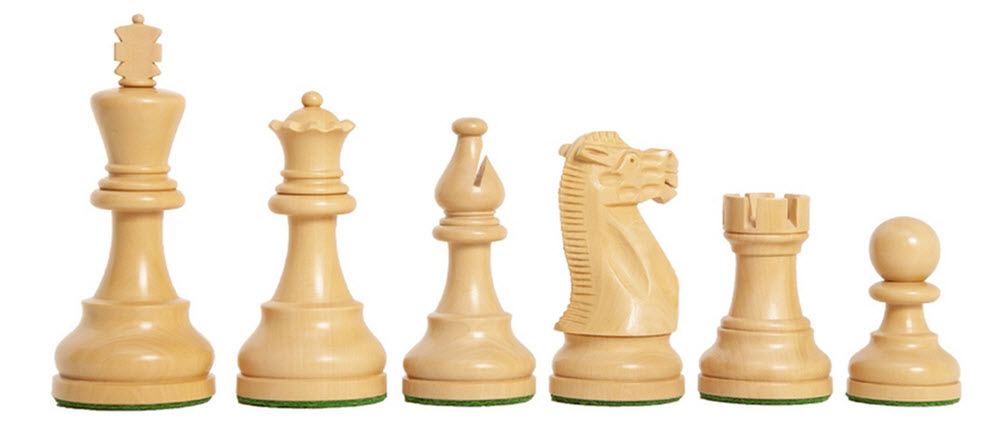Contents
For chess competitions, the international chess governing body FIDE recommends the use of a Staunton chess set. This is a well-known 19th-century design and it exists in several variations.

The original Staunton chess sets became available to the public in the fall of 1849, when Jaques of London began selling them. Jaques of London had the exclusive manufacturing rights to the set.
Among the reasons why the Staunton set became so popular we find the use of well-balanced, compact pieces that were also very easy to recognize. Also, the design with columns topped with a symbol allowed for fairly quick production of each piece (except the knight), which made it possible for Jaques of London to keep the price down.
In 1924, the Staunton set was selected as FIDE´s choice of set for international chess tournaments.
Who designed the original Staunton chess set?
On the patent, the journalist Nathaniel Cooke is credited with the design. According to some sources, the concept may actually have been conceived by his brother-in-law John Jaques, who was the owner of Jaques of London.
The design was registered at the Patent Office in 1849 as ”Ornamental Design for a set of Chess-Men”. At the time, the Ornamental Designs Act of 1842 did not include any provisions for patenting a design for anything made from ivory, so the patent was limited to Class 2, articles chiefly made of wood.
The name Staunton
This chess set is named after the renowned English chess master Howard Staunton. He did not design it, but he did endorse and promote it, and the first 500 sets were numbered and hand-signed by him. He even went so far as to lambaste other chess piece designs.
Background
As playing chess grew more widespread in Europe in the early 1800s, it became apparent that the use of widely varying piece designs was not without issues. Players were calling for a chess set that would be both easy to use and universally recognized by chess players from a multitude of backgrounds.
The pieces
The Staunton pieces are columns with a wide base. The king, queen, bishop and pawn all have a flat disk (”collar”) separating the body from the head, as they represent humans.
- The king piece has a stylized crown on top, and is the tallest of all the pieces. The crown is topped with a cross pattée.
- The queen piece has a coronet on top, and is slightly shorter than the king. The coronet is topped with a tiny ball (a monde).
- The bishop piece has a mitre on top. A crown emblem is stamped onto one of the bishops of each side, to identify their positioning on the king´s side of the board.
- The knight piece features no knight; it is only a horse head.
- The castle piece (rook) is streamlined to follow clean classical lines, which where much in vogue at the mid-19th century. It has stylized crenellated battlements. A crown emblem is stamped onto one of the rooks of each side, to identify their positioning on the king´s side of the board.
- The pawns each have around ball on top, and are the shortest of all the pieces. According to some experts, the form of the Staunton pawn may have been inspired by the Freemason´s Square and Compasses symbol.
The underside of each piece is covered in felt, to permit the piece to slide softer across the chess board.
The box
The original Staunton ebony and boxwood sets were weighted with led to make them more stable, since they were also the chess board.
The sets were typically sold in a papier-mâché case, and had a facsimile of Staunton´s signature under the lid. (Except for the first 500 sets which were actually hand-signed by him.)
Some ivory sets were produced, using ivory from African elephants.
Variants
There are currently 17 recognized variants of chess sets derived from the original 1849 Staunton design.
- Leuchars chess set (1849)
- Cooke chess set (1849–1850)
- Wedgewood chess set (1849)
- Morphy chess set (1851)
- Harrwitz chess set (1852–55)
- Paulsen chess set (1853–1855)
- Anderssen chess set (1855–65)
- Steinitz chess set (1865–70)
- Tarrasch chess set (1870–1875)
- Zukertort chess set (1875–80)
- Lasker chess set (1880–85)
- Pre-Hartston chess set (1885–1890)
- Hartston chess set (1890–1900)
- Marshall chess set (1900–15)
- Nimzovitch chess set (1927–1937)
- Broadbent chess set (1925–37)
- Lessing chess set (1927–1937)
